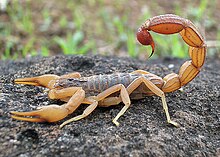Scorpiones
| Scorpions Temporal range: 430–0 Ma Early Silurian – Recent |
|
|---|---|
 |
|
| Hottentotta tamulus from Mangaon, Maharashtra, India | |
| Scientific classification | |
| Kingdom: | Animalia |
| Phylum: | Arthropoda |
| Subphylum: | Chelicerata |
| Class: | Arachnida |
| Order: |
Scorpiones C. L. Koch, 1837 |
| Superfamilies | |
|
See classification for families. |
|
See classification for families.
Scorpions are predatory arachnids of the order Scorpiones. They have eight legs and are easily recognized by the pair of grasping pedipalps and the narrow, segmented tail, often carried in a characteristic forward curve over the back, ending with a venomous stinger. Scorpions range in size from 9 mm / 0.3 in. (Typhlochactas mitchelli) to 23 cm / 9 in. (Heterometrus swammerdami).
The evolutionary history of scorpions goes back to the Silurian era 430 million years ago. They have adapted to a wide range of environmental conditions and can now be found on all continents except Antarctica. Scorpions number about 1750 described species, with 13 extant families recognised to date. Only about 25 of these species are known to have venom capable of killing a human being. The taxonomy has undergone changes and is likely to change further, as genetic studies are bringing forth new information.
Scorpion stings are painful but are usually harmless to humans. For stings from species found in North America, no treatment is normally needed for healthy adults, although medical care should be sought for children and for the elderly. More harmful stings from species found in South America, Africa, and western Asia may require medical attention.
The word is thought to have originated in Middle English between 1175 and 1225 AD from Old French scorpion, or from Italian scorpione, both derived from the Latin word scorpius, which is the romanization of the Greek word – skorpíos.
...
Wikipedia
